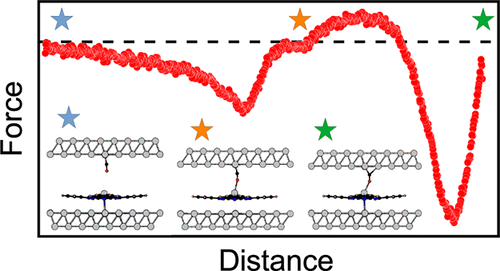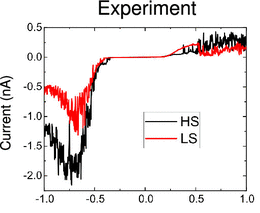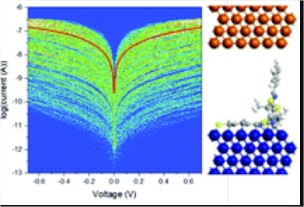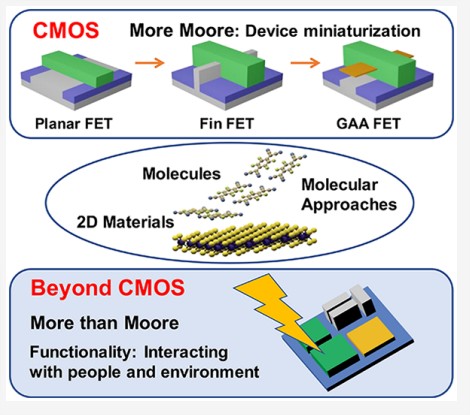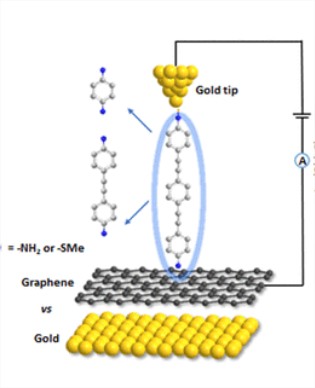publications
Nanofloating gate modulated synaptic organic light-emitting transistors for reconfigurable displays
The use of postsynaptic current to drive long-lasting luminescence holds a disruptive potential for harnessing the next-generation of smart displays. Multiresponsive long afterglow emission can be achieved by integrating light-emitting polymers in electric spiked transistors trigged by distinct presynaptic signals inputs. Here, we report a highly effective electric spiked long afterglow organic light-emitting transistor (LAOLET),… Read More
publications
Tracking the Interaction between a CO-Functionalized Probe and Two Ag-Phthalocyanine Conformers by Local Vertical Force Spectroscopy
Intentionally terminating scanning probes with a single atom or molecule belongs to a rapidly growing field in the quantum chemistry and physics at surfaces. However, the detailed understanding of the coupling between the probe and adsorbate is in its infancy. Here, an atomic force microscopy probe functionalized with a single CO molecule is approached with… Read More
publications
Redox-controlled conductance of polyoxometalate molecular junctions
We demonstrate the reversible in situ photoreduction of molecular junctions of a phosphomolybdate [PMo12O40]3− monolayer self-assembled on flat gold electrodes, connected by the tip of a conductive atomic force microscope. The conductance of the one electron reduced [PMo12O40]4− molecular junction is increased by ∼10, and this open-shell state is stable in the junction in air at room temperature. The… Read More
publications
Extraction of Chemical Reactivity and Structural Relaxations of an Organic Dye from the Short-Range Interaction with a Molecular Probe
A CO-functionalized atomic force microscope tip is used to locally probe local chemical reactivity and subtle structural relaxations of a single phthalocyanine molecule at different stages of pyrrolic-H abstraction. Spatially resolved vertical force spectroscopy unveils a variation of the maximum short–range attraction between CO and intramolecular sites, which is interpreted as a measure for the… Read More
publications
Encoding Information on the Excited State of a Molecular Spin Chain
The quantum states of nano-objects can drive electrical transport properties across lateral and local-probe junctions. This raises the prospect, in a solid-state device, of electrically encoding information at the quantum level using spin-flip excitations between electron spins. However, this electronic state has no defined magnetic orientation and is short-lived. Using a novel vertical nanojunction process,… Read More
publications
Combined spin filtering actions in hybrid magnetic junctions based on organic chains covalently attached to graphene
We present a bias-controlled spin-filtering mechanism in spin-valves including a hybrid organic chain/graphene interface. Wet growth conditions of oligomeric molecular chains would usually lead, during standard CMOS-compatible fabrication processes, to the quenching of spintronics properties of metallic spin sources due to oxidation. We demonstrate by X-ray photoelectron spectroscopy that the use of a protective graphene… Read More
publications
Negative Differential Resistance in Spin-Crossover Molecular Devices
We demonstrate, based on low-temperature scanning tunneling microscopy (STM) and spectroscopy, a pronounced negative differential resistance (NDR) in spin-crossover (SCO) molecular devices, where a FeII SCO molecule is deposited on surfaces. The STM measurements reveal that the NDR is robust with respect to substrate materials, temperature, and the number of SCO layers. This indicates that the… Read More
publications
Terphenylthiazole-based self-assembled monolayers on cobalt with high conductance photo-switching ratio for spintronics
Two new photo-switchable terphenylthiazole molecules are synthesized and self-assembled as monolayers on Au and on ferromagnetic Co electrodes. The electron transport properties probed by conductive atomic force microscopy in ultra-high vacuum reveal a larger conductance of the light-induced closed (c) form than for the open (o) form. We report an unprecedented conductance ratio of up… Read More
publications
Molecular Approach to Engineer Two-Dimensional Devices for CMOS and beyond-CMOS Applications
Two-dimensional materials (2DMs) have attracted tremendous research interest over the last two decades. Their unique optical, electronic, thermal, and mechanical properties make 2DMs key building blocks for the fabrication of novel complementary metal−oxide−semiconductor (CMOS) and beyond-CMOS devices. Major advances in device functionality and performance have been made by the covalent or noncovalent functionalization of 2DMs… Read More
publications
Asymmetric Effect on the Length Dependence of Oligo(Phenylene ethynylene)-Based Molecular Junctions
It is well known that the electrical conductance of molecular junctions in the tunneling regime varies exponentially with the length of the molecular backbone. This behavior is strongly influenced by anchoring groups, which connect the molecular backbone to the electrodes and locate the highest occupied molecular orbital (HOMO) and lowest unoccupied molecular orbital (LUMO) resonances… Read More


